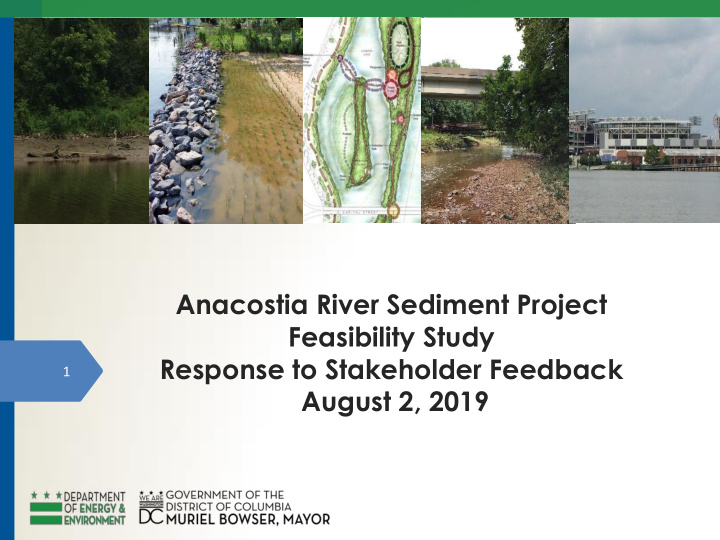



Anacostia River Sediment Project Feasibility Study Response to Stakeholder Feedback 1 August 2, 2019
Anacostia River Sediment Project (ARSP) 2 Study Area Operable Units (OUs) Three Operable Units Washington Channel Kingman Lake Main Stem
ARSP Study Area Potential Environmental 3 Cleanup Sites (PECSs) Pepco PEPCO Washington Washington Gas Light Navy Yard Washington Gas Light Washington Navy Yard
Themes 4 1. Interim Record of Decision (ROD)/ early action/adaptive management 2. Preliminary Remediation Goals (PRGs)/ Remedial Action Levels (RALs) 3. Background/fish ingestion rates (FIR) 4. Dredging depth 5. Ongoing sources 6. Potential Environmental Cleanup Sites (PECSs) 7. Additional technologies 8. Living shorelines/sediment reuse
Theme 1: Interim ROD/Early Action 5 DOEE intends to release a focused feasibility study to support an interim ROD approach. An Interim ROD could: Describe interim/early action(s) for each OU. Specify OU interim numerical clean-up goals for chemicals of concern (COCs). Use monitoring and an adaptive management framework that assesses measurable attainment of risk reduction expectations following interim actions. The final ROD will include final remedial goals.
Theme 1: Interim ROD/Early Action: 6 Potential Benefits Interim/early actions address the greatest contaminant areas and exposure potential. An interim ROD, as compared to a conventional ROD, can be implemented in an expedited manner. Supports an adaptive management approach to cleanup.
Theme 1: Interim ROD/Early Action: 7 Possible Early Actions Address hot spots. Address secondary areas with lower recontamination potential (Kingman Lake/Washington Channel). Limit PCBs entering the Anacostia from Lower Beaverdam Creek (source control, engineering control). Monitored natural recovery to address recontamination. Pilot tests for innovative in-situ technologies/methods (benched river banks, carbon additions/bio amendments).
Theme 1: Interim ROD/Early Action: 8 Other Possible Interim ROD Components Main Stem Interim Actions: Remediation at PECSs according to consent decrees/federal facility agreement; includes early-action remediation, baseline and long-term monitoring. Washington Channel Interim Actions : Specifies additional data needs, early-action remediation, baseline and long-term monitoring. Kingman Lake Interim Actions: Specifies additional data needs, early-action remediation, baseline and long-term monitoring.
Theme 1: Interim ROD/Early Action: 9 Monitoring and Remedy Performance Before remedial activities, adequate baseline data must be collected to track progress (EPA Directive 2002). Baseline monitoring to include annual (if possible) sampling of biota and surface water prior to remedial action; may also include passive sampling. Evaluates multiple years of performance monitoring data to interpret results for full understanding. Considers lessons learned to design a future remedy and final ROD.
Theme 2: PRGs/RALs 10 PRGs will be achieved over time. The interim site-wide average RAL is 200 ppb for PCBs. DOEE is considering establishing an ARSP- wide “hot - spot” clean -up goal for PCBs, which would be higher than the interim RAL. Additional PECS-specific interim RALs (e.g., WGL, Pepco, WNY) may be established through the consent decree process. Final RALs will be specified through additional sampling/adaptive management.
Theme 3: Background/ 11 Fish Ingestion Rates (FIR) Background concentration for each COC sets the floor for the cleanup level: 65 ppb for PCBs. DOEE is reviewing NPS draft report on non-tidal tributary bottom sediment sampling and background calculation. Data will be considered and discussed in ARSP project documents. FIRs have been adjusted in the FS and the revised RI based on stakeholder RI comments: 65 g/day for adult subsistence fishers.
Theme 4: Dredging Depth 12 In response to stakeholder comments, DOEE has solicited additional community input regarding current and future use of the Anacostia River: River Use Survey. River Use Survey asks 24 questions to gain insight into existing and anticipated future use preferences for the Federal Navigational Channel (FNC). 22 large and/or frequent boaters surveyed. Anacostia FNC preferences: depth - up to 12 feet; width - up to 250 feet. Seafarers Yacht Club can currently only boat during high tide. DOEE is continuing a dialogue with the U.S. Army Corps of Engineers to discuss its plans for future Anacostia River dredging and flood control.
Theme 5: Ongoing Sources 13 MWCOG/DOEE established a Source Control Work Group with federal, state, and local jurisdictional entities to address ongoing, primarily upstream sources. DOEE had several recent meetings with the Maryland Department of the Environment (MDE) to discuss a plan to assess upstream contamination into the Anacostia. MDE is developing a work plan to address upstream sources that may be incorporated into the interim ROD. DOEE is working to identify and eliminate potential ongoing sources within the District.
Theme 6: Potential Environmental 14 Cleanup Sites Pepco, Washington Gas, and Washington Navy Yard sites will continue to be treated as PECSs in the focused FS. PECSs will follow the clean-up processes in their consent decrees/Federal Facility Agreement. DOEE expects PECSs to achieve final cleanup numbers that are consistent with ARSP goals.
Theme 7: Additional Technologies 15 Innovative technologies will be considered in the focused FS. DOEE will consider pilot tests that use innovative in-situ technologies/methods (benched river banks, carbon additions/bio amendments). Full scale remedies may be considered if pilot testing is effective.
Theme 8: Living Shorelines/Sediment Reuse 16 DOEE will assess living shorelines and sediment reuse moving forward. Wetlands created or restored can mitigate impacts from flooding and storm surge. Long term effectiveness of the beneficial use areas is considered comparable to protectiveness of off-site disposal while meeting restoration objectives for living shorelines.
Next Steps 17 Incorporate comments into FS and appendices Release Proposed Plan in Autumn Interim Record of Decision 12/31/19 Interim Remedial Preliminary Focused Interim Record Proposed Design for Long-term Assessment/ Remedial Feasibility Remedial Final ROD Site Investigation Plan Interim Management of Study Actions Investigation Actions Decision
Recommend
More recommend